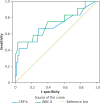A grey zone of hyperamylasemia following endoscopic retrograde cholangiopancreatography: follow-up and differential diagnosis from acute pancreatitis
- PMID: 33786115
- PMCID: PMC7991937
- DOI: 10.5114/wiitm.2020.94545
A grey zone of hyperamylasemia following endoscopic retrograde cholangiopancreatography: follow-up and differential diagnosis from acute pancreatitis
Abstract
Introduction: Endoscopic retrograde cholangiopancreatography (ERCP) is a tool often used for treating and diagnosing pancreaticobiliary diseases. One of the important complications of ERCP is pancreatitis. Even though transient hyperamylasemia is a more common and benign situation, it must be distinguished from post-ERCP pancreatitis.
Aim: To define the risk factors associated with post-ERCP pancreatitis (PEP) and tried to identify a cutoff about laboratory findings for positive or negative prediction.
Material and methods: We reviewed the medical files of patients who underwent ERCP for choledocholithiasis in a retrospective cohort study. The primary outcome is the risk factors associated with PEP. Receiver operator characteristics analysis was carried out for determination of cut-offs for laboratory parameters.
Results: The presence of cholangitis (p = 0.018), Wirsung cannulation (p = 0.008), presence of abdominal pain at 12th and 24th h (p < 0.001), amylase level at 12th h (p < 0.001), C-reactive protein (CRP) levels at 6th and 12th h (p = 0.001 and p < 0.001), white blood cells (WBC) levels at 6th and 12th h (p = 0.001 and p < 0.001) were significant for development of PEP. CRP levels above 8 mg/l and WBC above 10 × 103 had negative predictive values over 70% and 90% respectively.
Conclusions: Physical examination and inflammatory parameters are important in diagnosis of PEP. CRP and WBC have high negative predictivity and sensitivity. Amylase level increase was most apparent 12 h after ERCP and significantly higher (p < 0.001) for the development of PEP. The first abdominal pain evaluation is meaningful at the 12th h timepoint because insufflation during the procedure and other causes of abdominal pain may result in misinterpretation.
Keywords: acute pancreatitis; endoscopic retrograde cholangiopancreatography; hyperamylasemia.
Copyright: © 2020 Fundacja Videochirurgii.
Conflict of interest statement
The authors declare no conflict of interest.
Figures
References
-
- Solomon S, Baillie J. Indications for and Contraindications to ERCP. In: Baron TH, Kozarek RA, Carr-Locke D, editors. ERCP. 3rd Edition. Elsevier; 2019.
LinkOut - more resources
Full Text Sources
Other Literature Sources
Research Materials
Miscellaneous



